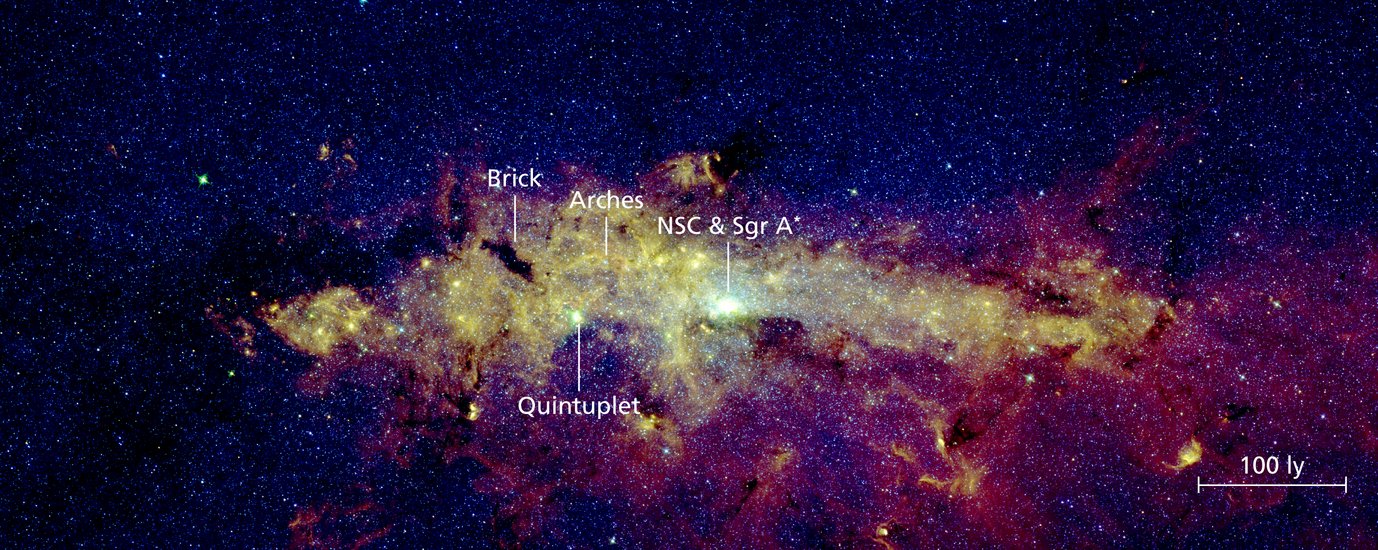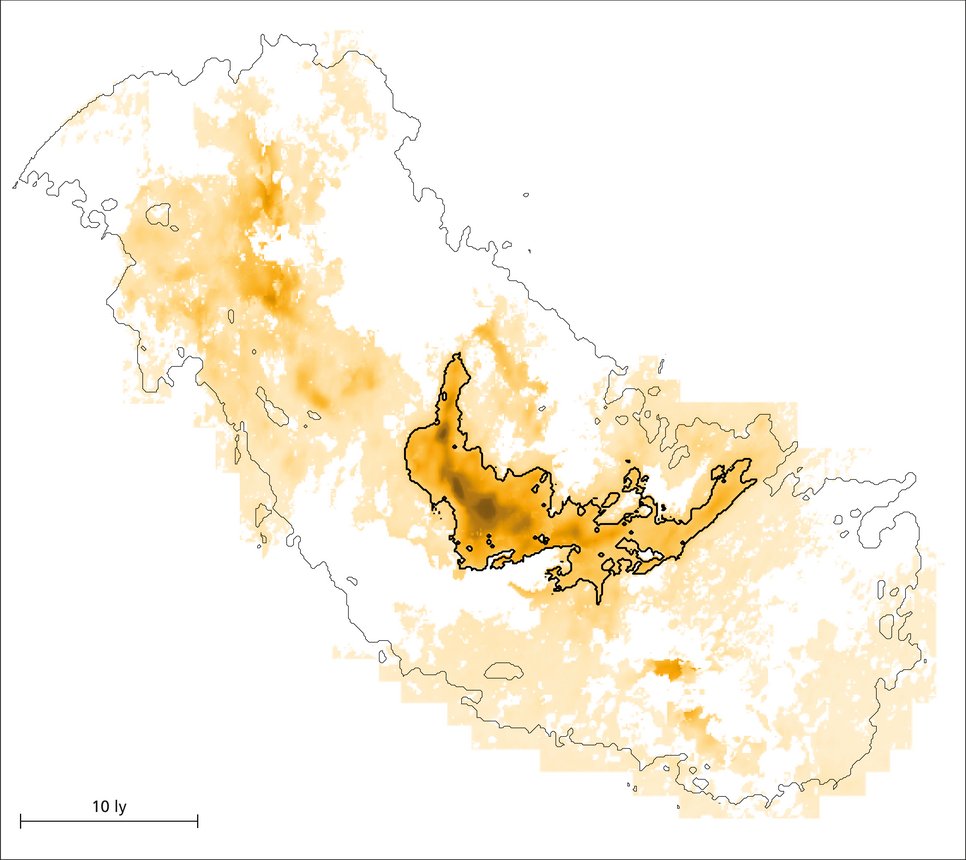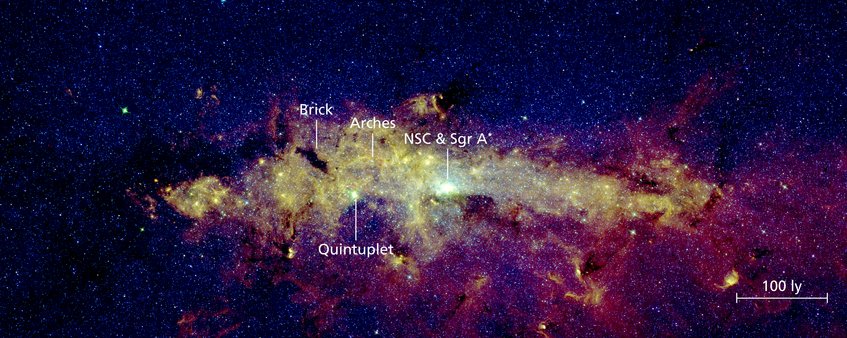A bubble in the Brick
Enigmatic cloud near the Galactic Centre may be richer in young stars than previously thought
A group of astronomers led by the Max Planck Institute for Astronomy found evidence for a young stellar cluster hidden inside a cloud known as “the Brick”. This cloud near the Galactic Centre so far appeared unusually quiescent regarding star formation. The new finding follows from an arc-shaped substructure whose properties are consistent with an expanding shell. The authors link it to a bubble of hot gas produced by the stellar wind of a young massive star. Since massive stars rarely form in isolation, the bubble could indicate the presence of a young stellar cluster, equivalent to several hundred solar masses.

Stars form inside dense pockets of clouds made of gas and dust. Generally, whenever a cloud is dense enough, stars will eventually form. However, this rule of thumb does not appear to hold entirely for the region around the Milky Way centre. The Central Molecular Zone (CMZ), a gas complex with a diameter between 1000 and 2000 light-years around the Galactic Centre, contains some of the densest and most massive gas clouds known in the Milky Way. However, apart from a few extraordinarily massive stellar clusters, many of those clouds show surprisingly little evidence of widespread star formation activity.
To explore this apparent contradiction, a group of astronomers led by Jonathan Henshaw from the Max Planck Institute for Astronomy (MPIA) in Heidelberg, Germany, investigated one of the most enigmatic clouds in the CMZ, called “the Brick”. It is well known for its high density and mass, equivalent to about 100,000 suns. Still, it appears to produce comparatively few stars.
“When investigating the gas motion of the Brick, we find one component that stands out,” says Jonathan Henshaw. He is the lead author of the underlying article published in the Monthly Notices of the Royal Astronomical Society. “That sub-structure, confined to a narrow range of velocities, resembles a crescent-shaped arc,” Henshaw adds.

Such arcs have been detected in regions of high-mass star formation. They can represent the material swept up by an expanding shell. High-mass stars deliver energy and momentum to their surroundings, which act as the driving force of the expansion. Based on this assumption, the research group derived a shell diameter of 8.5 light-years and an expansion velocity of approximately 5 kilometres per second. By tracing this motion back to its origin, the astronomers dated the beginning of the expansion back to a few hundred thousand years ago. This is just a wink of an eye, considering the timescales typical of cosmic phenomena.
Interestingly, Henshaw and his collaborators also find emissions from ionised gas coinciding with the arc cavity. This gas traced by radio emission exhibits a velocity consistent with the arc’s motion, which indicates a direct relationship between the hot ionised and the cold molecular gas.
“We explored several plausible scenarios that may account for an expanding envelope forming the arc,” Henshaw reports. He continues: “Comparing predictions from theory to our observations, we found that the stellar wind from a massive star of about 20 solar masses is likely the dominant mechanism.”
Altogether, the picture of an expanding bubble of hot gas driven by the stellar wind of a massive star formed inside the Brick is the most likely explanation for the arc‘s origin so far. This result puts the seemingly dormant Brick into a completely new perspective. Massive stars only rarely form in isolation. They usually mark the presence of an entire cluster of young stars of varying mass. If this were the case for the Brick, it might be less quiescent than previously thought.
To estimate the mass of the supposed group of stars, the astronomers simulated 10,000 clusters. A statistical analysis of those clusters with the most massive stars having 16 to 20 times the mass of the Sun points to a range of cluster masses between 400 and 700 solar masses. The authors of the underlying research article also demonstrated that with the currently available instrumentation, such clusters may easily be hidden in the confusion of the many stars detected towards the Galactic Centre and the obscuration of those stars by intervening gas and dust.
To better reveal the internal stellar population of the Brick, the astronomers are hoping for the James Webb Space Telescope still bound to launch in 2021. Those results will help them determine the underlying stellar population of the Brick and potentially locate the driving source of the arc.
Additional Information
The team consists of J. D. Henshaw (Max Planck Institute for Astronomy, Heidelberg, Germany [MPIA]), M. R. Krumholz (MPIA; Australian National University, Canberra, Australia; ARC Centre of Excellence for Astronomy in Three Dimensions, Canberra, Australia; ZAH, Universität Heidelberg, Germany), N. O. Butterfield (Villanova University, USA), J. Mackey (Dublin Institute for Advanced Studies, Ireland), A. Ginsburg (University of Florida, Gainesville, USA [UFL]), T. J. Haworth (Queen Mary University of London, UK), F. Nogueras-Lara (MPIA), A. T. Barnes (Universität Bonn, Germany), S. N. Longmore (Liverpool John Moores University, UK), J. Bally (University of Colorado, USA), J. M. D. Kruijssen (ARI, Universität Heidelberg, Germany), E. A. C. Mills (University of Kansas, Lawrence, USA), H. Beuther (MPIA), D. L. Walker (University of Connecticut, Storrs, USA [UCONN]), C. Battersby (UCONN), A. Bulatek (UFL), T. Henning (MPIA), J. Ott (National Radio Astronomy Observatory, Socorro, USA; New Mexico Institute of Mining and Technology, Socorro, USA), and J. D. Soler (MPIA; Istituto di Astrofisica e Planetologia Spaziali, Istituto Nazionale di Astrofisica, Rome, Italy).
MN

